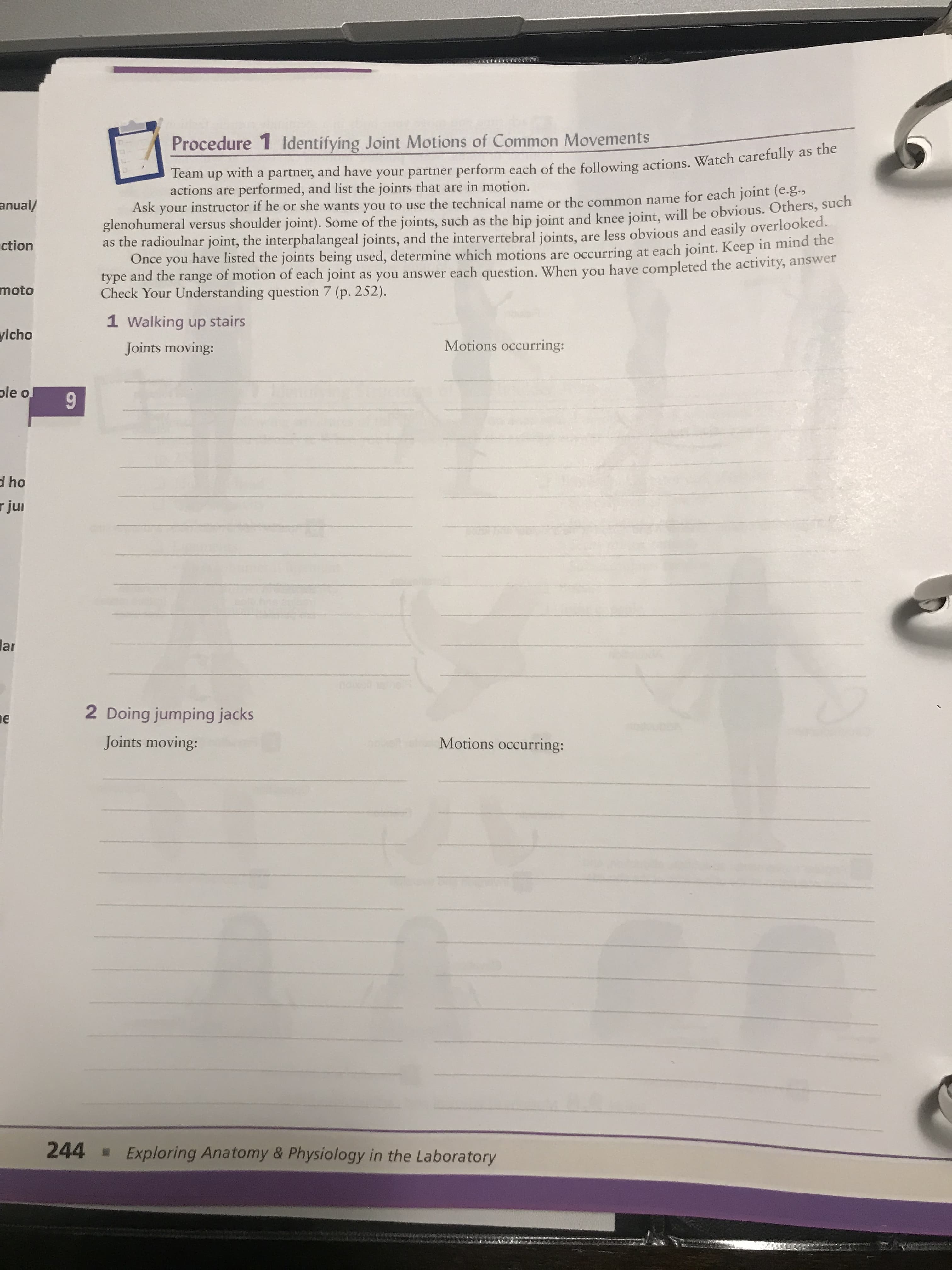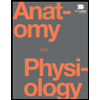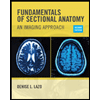Procedure 1 ldentifying Joint Motions of Common Movements Team up with a partner, and have your partner perform each of the following a actions are performed, and list the joints that are in motion ctions. Watch carefully as the for each joint (e.g., anual/ Ask your instructor if he or she wants you to use the technical name or the common name ious. Others, such be obv glenohumeral versus shoulder joint). Some of the joints, such as the hip joint and knee joint, will as the radio ulnar joint, the interphala ngeal joints, and the intervertebral joints, are less obvious and easily overlooked. ised, determine which motions are occurring at each joint. Keep in mind the leted the activity, answer ction Once you have listed the joints being motions are type and the range of motion of each joint as you answer each question. When you have comp Check Your Understanding question 7 (p. 252). moto 1 Walking up stairs lcho Joints moving: Motions occurring: le o dho r jui lar 2 Doing jumping jacks Joints moving: Motions occurring: 244 Exploring Anatomy& Physiology in the Laboratory
Procedure 1 ldentifying Joint Motions of Common Movements Team up with a partner, and have your partner perform each of the following a actions are performed, and list the joints that are in motion ctions. Watch carefully as the for each joint (e.g., anual/ Ask your instructor if he or she wants you to use the technical name or the common name ious. Others, such be obv glenohumeral versus shoulder joint). Some of the joints, such as the hip joint and knee joint, will as the radio ulnar joint, the interphala ngeal joints, and the intervertebral joints, are less obvious and easily overlooked. ised, determine which motions are occurring at each joint. Keep in mind the leted the activity, answer ction Once you have listed the joints being motions are type and the range of motion of each joint as you answer each question. When you have comp Check Your Understanding question 7 (p. 252). moto 1 Walking up stairs lcho Joints moving: Motions occurring: le o dho r jui lar 2 Doing jumping jacks Joints moving: Motions occurring: 244 Exploring Anatomy& Physiology in the Laboratory
Chapter6: The Skeletal System
Section: Chapter Questions
Problem F1CRE
Related questions
Question

Transcribed Image Text:Procedure 1 ldentifying Joint Motions of Common Movements
Team up with a partner, and have your partner perform each of the following a
actions are performed, and list the joints that are in motion
ctions. Watch carefully as the
for each joint (e.g.,
anual/
Ask your instructor if he or she wants you to use the technical name or the common name
ious. Others, such
be obv
glenohumeral versus shoulder joint). Some of the joints, such as the hip joint and knee joint, will
as the radio
ulnar joint, the interphala
ngeal joints, and the intervertebral joints, are less obvious and easily overlooked.
ised, determine which motions are occurring at each joint. Keep in mind the
leted the activity, answer
ction
Once you have listed the joints being
motions are
type and the range of motion of each joint as you answer each question. When you have comp
Check Your Understanding question 7 (p. 252).
moto
1 Walking up stairs
lcho
Joints moving:
Motions occurring:
le o
dho
r
jui
lar
2 Doing jumping jacks
Joints moving:
Motions occurring:
244 Exploring Anatomy& Physiology in the Laboratory
Expert Solution
This question has been solved!
Explore an expertly crafted, step-by-step solution for a thorough understanding of key concepts.
This is a popular solution!
Trending now
This is a popular solution!
Step by step
Solved in 5 steps

Recommended textbooks for you


Anatomy & Physiology
Biology
ISBN:
9781938168130
Author:
Kelly A. Young, James A. Wise, Peter DeSaix, Dean H. Kruse, Brandon Poe, Eddie Johnson, Jody E. Johnson, Oksana Korol, J. Gordon Betts, Mark Womble
Publisher:
OpenStax College

Fundamentals of Sectional Anatomy: An Imaging App…
Biology
ISBN:
9781133960867
Author:
Denise L. Lazo
Publisher:
Cengage Learning


Anatomy & Physiology
Biology
ISBN:
9781938168130
Author:
Kelly A. Young, James A. Wise, Peter DeSaix, Dean H. Kruse, Brandon Poe, Eddie Johnson, Jody E. Johnson, Oksana Korol, J. Gordon Betts, Mark Womble
Publisher:
OpenStax College

Fundamentals of Sectional Anatomy: An Imaging App…
Biology
ISBN:
9781133960867
Author:
Denise L. Lazo
Publisher:
Cengage Learning

Understanding Health Insurance: A Guide to Billin…
Health & Nutrition
ISBN:
9781337679480
Author:
GREEN
Publisher:
Cengage


Medical Terminology for Health Professions, Spira…
Health & Nutrition
ISBN:
9781305634350
Author:
Ann Ehrlich, Carol L. Schroeder, Laura Ehrlich, Katrina A. Schroeder
Publisher:
Cengage Learning